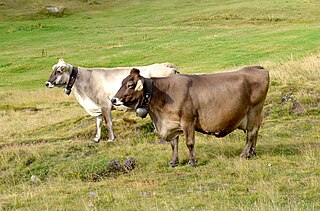
A breed is a specific group of domestic animals having homogeneous appearance (phenotype), homogeneous behavior, and/or other characteristics that distinguish it from other organisms of the same species. In literature, there exist several slightly deviating definitions. Breeds are formed through genetic isolation and either natural adaptation to the environment or selective breeding, or a combination of the two. Despite the centrality of the idea of "breeds" to animal husbandry and agriculture, no single, scientifically accepted definition of the term exists. A breed is therefore not an objective or biologically verifiable classification but is instead a term of art amongst groups of breeders who share a consensus around what qualities make some members of a given species members of a nameable subset.

The Charolais or Charolaise is a French breed of taurine beef cattle. It originates in, and is named for, the Charolais area surrounding Charolles, in the Saône-et-Loire department, in the Bourgogne-Franche-Comté region of eastern France. Charolais are raised for meat; they may be crossed with other breeds, including Angus and Hereford cattle.

The Galloway is a Scottish breed of beef cattle, named after the Galloway region of Scotland, where it originated during the seventeenth century.

The Red Angus is an international breed of beef cattle characterised by a reddish-brown coat colour. It derives from the Scottish Aberdeen Angus population and, apart from the coat colour, is identical to it. Red Angus are registered separately from black Angus cattle in Australia, Canada, and the United States.

The Dexter is an Irish breed of small cattle. It originated in the eighteenth century in County Kerry, in south-western Ireland, and appears to be named after a man named Dexter, who was factor of the estates of Lord Hawarden on Valentia Island. Until the second half of the nineteenth century it was considered a type within the Kerry breed.

The Mishima is a critically-endangered Japanese breed of beef cattle. It is found only on Mishima Island, some 50 km north-west of Hagi, in Yamaguchi Prefecture, Japan. It is one of six native Japanese cattle breeds, and one of two small populations that have never been cross-bred with Western cattle, the other being the Kuchinoshima breed from Kuchinoshima island in the Tokara Island group.
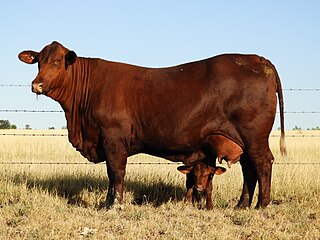
The Santa Gertrudis is an American breed of beef cattle. It is a taurine-indicine hybrid breed, descended from both zebu and European cattle. It was bred in the early twentieth century in Texas, and received official recognition in 1940. It has been exported to many countries including Australia, Brazil and South Africa, and has contributed to the development of a number of modern breeds, among them the Barzona and the Droughtmaster.

The Devon is a traditional British breed of beef cattle. It originated in, and is named for, the county of Devon in the West Country of England. It is a deep rich red in colour, and so may be known as the Devon Ruby or Red Ruby; it may also be called the North Devon to distinguish it from the South Devon.

The Sussex is a British breed of red beef cattle from the Weald of Sussex, Surrey and Kent, in south-eastern England. Its traditional use as a draught ox on the Weald continued into the twentieth century. From the late nineteenth century it began to be selectively bred for beef production. It has been exported to many countries of the world; the largest population is in South Africa, where there may be half a million head.

Kalmyk cattle is a beef cattle breed originated in Mongolia and northwestern China, in the early 17th century it was taken to southwestern Russia by migrating Kalmyk tribes. Today they can be found in central Asia and Southern Russia on dry steppe pastures.
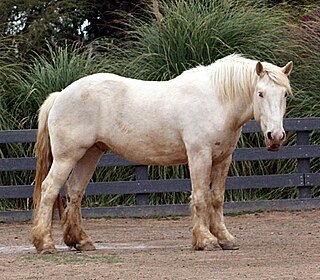
In modern agriculture, a rare breed is a breed of poultry or livestock that has a very small breeding population, usually from a few hundred to a few thousand. Because of their small numbers, rare breeds may have a threatened conservation status, and they may be protected under regional laws. Many countries have organizations devoted to the protection and promotion of rare breeds, for which they each have their own definition. In botany and horticulture, the parallel to rare animal breeds are heirloom plants, which are rare cultivars.
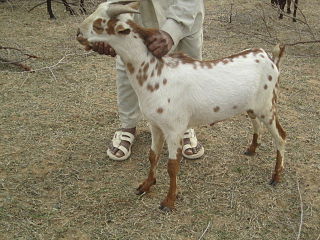
The Barbari or Bari is a breed of small domestic goat found in a wide area in India and Pakistan. It is distributed in the states of Haryana, Punjab and Uttar Pradesh in India, and in Punjab and Sindh provinces of Pakistan.

The Asil or Aseel is an Indian breed or group of breeds of game chicken. It is distributed in much of India, particularly in the states of Andhra Pradesh, Chhattisgarh and Odisha; it has been exported to several other countries. Similar fowl are found throughout much of Southeast Asia.

Cattle are large, domesticated, cloven-hooved, herbivores. They are a prominent modern member of the subfamily Bovinae and the most widespread species of the genus Bos. Adult females are referred to as cows and adult males are referred to as bulls, although the term "cow" is often used to refer to both male and female cattle.
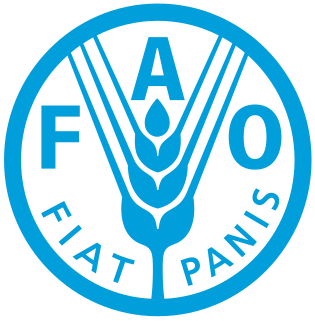
DAD-IS is the acronym of the worldwide Domestic Animal Diversity Information System of the Food and Agriculture Organization of the United Nations, within the FAO's management of animal genetic resources programme. It includes a searchable database of information about breeds, the Global Databank for Animal Genetic Resources; it also holds tools for management, and contacts for the National and Regional Coordinators for the programme. Data from the Global Databank is used for reporting on the global status and trends of animal genetic resources. The fourth version of the DAD-IS was launched on 21 November 2017.
Mozambique has a variety of regional cropping patterns; agro-climatic zones range from arid and semi-arid to the sub-humid zones to the humid highlands. The most fertile areas are in the northern and central provinces, which have high agro-ecological potential and generally produce agricultural surpluses. Southern provinces have poorer soils and scarce rainfall, and are subject to recurrent droughts and floods.
The business of livestock farming is prominent in the Basque Country (Spain). The climate of this region is ideal for raising cattle and other livestock and is classified as Atlantic, or warm and rainy. The most common breeds of livestock raised in this region include beef cattle, dairy cattle, sheep, goats, and horses. These animals are most often raised in mixed farms, or farms that contain a combination of these types of animals and not just one type exclusively. Although the number of livestock farms notably decreased between the years of 1999 and 2009, the number of animals raised on each remaining farm increased dramatically, as discussed in further detail below. In 2006, there were estimated to be about 19,000 Basque farms that involved the raising of livestock.

Cryoconservation of animal genetic resources is a strategy wherein samples of animal genetic materials are preserved cryogenically.

Animal genetic resources for food and agriculture (AnGR), also known as farm animal genetic resources or livestock biodiversity, are genetic resources of avian and mammalian species, which are used for food and agriculture purposes. AnGR is a subset of and a specific element of agricultural biodiversity.

The Red Brangus is an American breed of hybrid beef cattle, with both taurine and indicine genetic heritage. Development began in Texas in the 1940s. It is a colour variant of the Brangus, a hybrid of American Angus and Brahman cattle, and differs from it only in colour. There are two herd-books, one international and one American. For international registration the animal must be of 5/8 Angus and 3/8 Brahman descent; in the United States, it may be any mix of the two breeds, but registration is conditional on inspection.

















